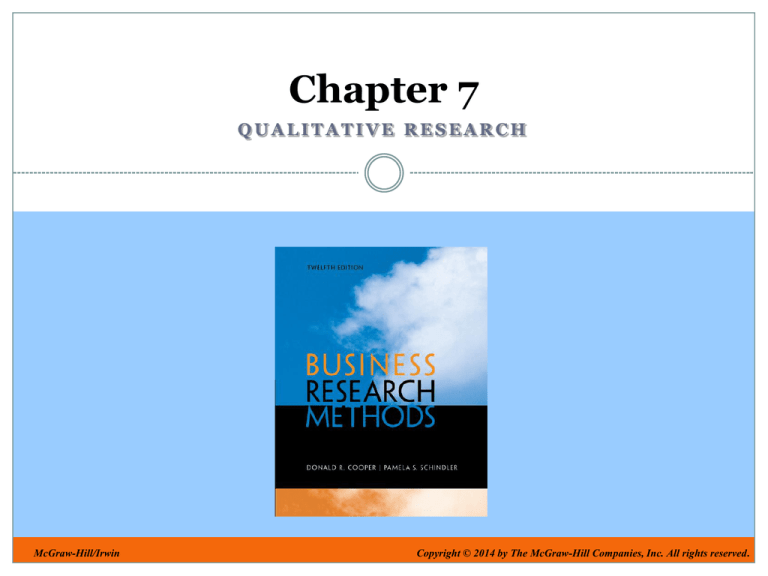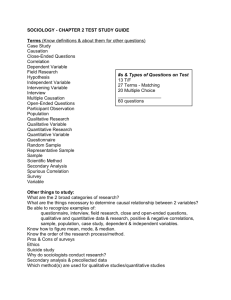
Chapter 7
QUALITATIVE RESEARCH
McGraw-Hill/Irwin
Copyright © 2014 by The McGraw-Hill Companies, Inc. All rights reserved.
Qualitative
Research
and the
Research
Process
7-2
Qualitative Research
Group
Interviews
Observation
Ethnography
Focus Groups
Data
Collection
Techniques
Action
Research
IDIs
Case Studies
Grounded
Theory
7-3
Qualitative Research
Textual Analysis
Behavioral
Observations
Artifacts
Trace
Evidence
Other
Techniques
Debriefings
7-4
Qualitative Research in Business
Job Analysis
Retail Design
Advertising Concept
Process
Development
Productivity
Enhancement
New Product
Development
Benefits Management
Understanding
Union
Representation
Market Segmentation
Sales Analysis
7-5
Data Sources
People
Organizations
Texts
Environments
Artifacts/ media products
Events and happenings
7-6
The Roots of Qualitative Research
Qualitative
Research
Economics
Psychology
Sociology
Semiotics
Anthropology
Communication
7-7
Distinction between Qualitative &
Quantitative
Theory
Building
Theory
Testing
7-8
Focus of Research
Qualitative
Understanding
Interpretation
Quantitative
Description
Explanation
7-9
Researcher Involvement
Qualitative
High
Participation-based
Quantitative
Limited
Controlled
7-10
Time Duration
Qualitative
Longitudinal
Multi-method
Quantitative
Cross-sectional or
longitudinal
Single method
7-11
Sample Design and Size
Qualitative
Non-probability
Purposive
Small sample
Quantitative
Probability
Large sample
7-12
Data Type and Preparation
Qualitative
Verbal or pictorial
Reduced to verbal
codes
Quantitative
Verbal descriptions
Reduced to numeric
codes
7-13
Turnaround
Qualitative
Shorter turnaround possible
Insight development ongoing
Quantitative
May be time-consuming
Insight development follows
data entry
7-14
Data Analysis
Qualitative
Nonquantitative
Human judgment mixed
with fact
Emphasis on themes
Quantitative
Computerized analysis
Facts distinguished
Emphasis on counts
7-15
Qualitative
Research
and the
Research
Process
7-16
Pretasking Activities
Use product in home
Bring visual stimuli
Create collage
Keep diaries
Draw pictures
Construct a story
7-17
Pretasking Activities
7-18
Formulating
the
Qualitative
Research
Question
7-19
Choosing the Qualitative Method
Project’s
purpose
Researcher
characteristics
Schedule
Factors
Types of
participants
Budget
Topics
7-20
NonProbability Sampling
Purposive
Sampling
Snowball
Sampling
Convenience
Sampling
7-21
Qualitative Sampling
General sampling rule:
Keep conducting interviews until no
new insights are gained.
7-22
The Interview Question Hierarchy
7-23
Interviewer Responsibilities
Recommends topics
Develops pretasking
and questions
Controls interview
Plans location and
facilities
Proposes criteria for
drawing sample
Writes screener
Recruits participants
activities
Prepares research tools
Supervises
transcription
Helps analyze data
Draws insights
Writes report
7-24
Elements of a Recruitment Screener
Heading
Behavior questions
Screening
Lifestyle questions
requirements
Identity information
Introduction
Security questions
Demographic
questions
Attitudinal and
knowledge questions
Articulation and
creative questions
Offer/ Termination
7-25
Interview Formats
Unstructured
Semi-structured
Structured
7-26
Requirements: Unstructured Interviews
Developed dialog
Probe for
answers
Distinctions
Interviewer
creativity
Interviewer skill
7-27
The Interview Mode
Individual
Group
7-28
IDI vs Group
Participants
Topic
Concerns
Research
Objective
Individual Interview
• Explore life of individual in depth
• Create case histories through
repeated interviews over time
• Test a survey
Group Interview
•
•
•
•
•
Detailed individual experiences,
choices, biographies
Sensitive issues that might
provoke anxiety
• Time-pressed participants or those
difficult to recruit (e.g., elite or highstatus participants)
• Participants with sufficient language
skills (e.g., those older than seven)
• Participants whose distinctions
would inhibit participation
•
•
Orient the researcher to a field of inquiry and
the language of the field
Explore a range of attitudes, opinions, and
behaviors
Observe a process of consensus and
disagreement
Issues of public interest or common concern
Issues where little is known or of a hypothetical
nature
• Participants whose backgrounds are similar or
not so dissimilar as to generate conflict or
discomfort
• Participants who can articulate their ideas
• Participants who offer a range of positions on
issues
7-29
Research Using IDIs
Oral histories
Sequential
interviewing
Life histories
Types
Critical
incident
techniques
Cultural
interviews
Ethnography
7-30
Projective Techniques
Laddering
Semantic
Mapping
Sensory sorts
Component
Sorts
MET
Data
Collection
Techniques
Imagination
Exercises
Association
Sentence
Completion
Cartoons
Thematic
Apperception
7-31
Group Interviews
Mini-Groups
Dyads
Triads
Small Groups
Focus Groups
Supergroups
7-32
Determining the Number of Groups
Scope
Number of distinct segments
Desired number of ideas
Desired level of detail
Level of distinction
Homogeneity
7-33
Group Interview Modes
Face-to-Face
Telephone
Online
Videoconference
7-34
Combining Qualitative Methodologies
Case Study
Action Research
7-35
Triangulation: Merging Qualitative and
Quantitative
Conduct studies
simultaneously
Ongoing qualitative
with multiple waves
of quantitative
Perform series:
Qualitative,
Quantitative,
Qualitative
Quantitative
precedes
Qualitative
7-36







